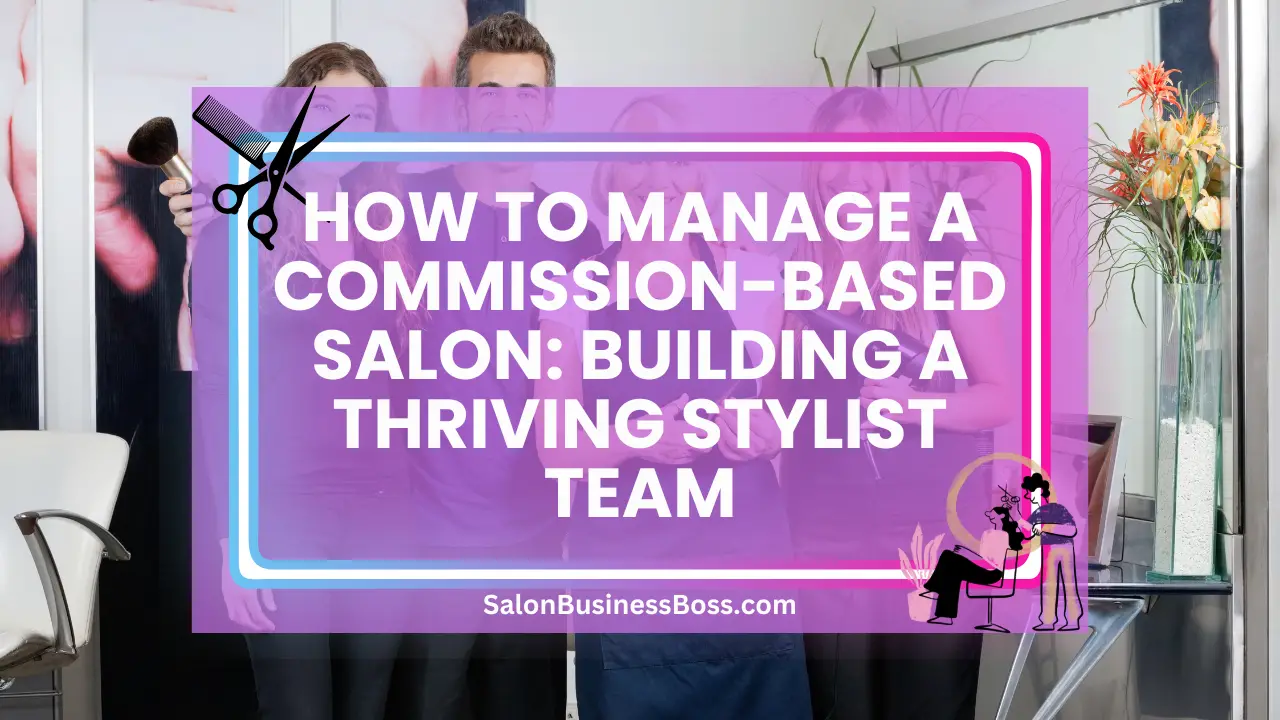Running a commission-based salon can be a rewarding venture for both salon owners and stylists. By structuring compensation around commissions, salon owners can motivate stylists to perform at their best, ensuring a high level of client satisfaction and retention. For stylists, commission-based pay offers the potential to earn substantial income, directly tied to their skills and sales abilities. In this article, we will explore the key strategies and considerations for running a successful commission-based salon, focusing on how to optimize earnings for both salon owners and stylists.
1. Understanding the Commission Structure

The compensation structure serves as the cornerstone of a commission-based salon, defining the relationship between stylists and the salon. In this model, stylists receive a predetermined percentage of the revenue generated from the services they provide, while the remaining portion is retained by the salon. For instance, if a stylist is on a 40% commission rate and sells a $100 service to a client, they would earn $40, and the salon would keep $60.
The key challenge for salon owners lies in striking the right balance between the commission rate and the salon’s base pay. Offering a higher base pay may attract skilled stylists, but it could lead to lower commission rates, which might diminish their motivation to upsell additional services and products. Conversely, a lower base pay may incentivize stylists to focus more on upselling to increase their earnings through commissions.
Finding the optimal balance requires careful consideration of several factors, including the local market conditions, competition, and the skill level of the stylists. It is essential to design a compensation structure that aligns with the salon’s financial goals while providing sufficient motivation for stylists to excel in their sales and service efforts.
A well-designed commission structure should not only incentivize stylists to upsell and cross-sell but also promote a collaborative and client-centric approach. By compensating stylists based on their performance, the salon can foster a culture of excellence, encouraging stylists to continuously improve their skills and customer service.
The compensation structure is a critical aspect of a commission-based salon. Striking the right balance between commission rates and base pay is vital in motivating stylists to deliver outstanding service, upsell effectively, and contribute to the salon’s overall success. By carefully evaluating market dynamics and aligning incentives with the salon’s objectives, salon owners can create a thriving and rewarding environment for both stylists and the business.
Read more about: Commission-Based Salon Ownership: Steps and Practices
2. Attracting and Retaining Top Talent
To build a thriving commission-based salon, attracting and retaining top talent is of utmost importance. A salon’s success heavily relies on the expertise and dedication of its stylists. Therefore, investing time and resources in recruiting skilled and experienced professionals who align with the salon’s vision and brand is essential. When seeking new stylists, consider their track record, portfolio, and client reviews to ensure they meet the salon’s standards of excellence.
Offering competitive commission rates is a powerful tool to motivate stylists to perform at their best. A well-structured commission plan should strike a balance between providing fair compensation to stylists and maintaining the overall profitability of the salon. While an attractive commission rate can attract talented stylists, it should also align with the salon’s financial goals to ensure its long-term sustainability.
Creating a positive and supportive work environment can significantly impact talent retention. Nurturing a culture of teamwork, recognition, and growth fosters loyalty among stylists. Regularly acknowledging their achievements and contributions can boost morale and reinforce a sense of belonging, reducing turnover rates and cultivating a committed and motivated team.
3. Providing Effective Training and Development
Continuous training and development are pivotal to maximizing earnings for both stylists and the salon. The beauty industry is constantly evolving, with new trends, techniques, and products emerging regularly. To provide exceptional services and remain competitive, stylists must stay updated on the latest advancements.
Offering workshops, seminars, and mentorship programs allows stylists to refine their skills and stay at the cutting edge of the industry. A well-trained team not only attracts more clients but also enhances customer satisfaction through top-notch services. Happy clients are more likely to become loyal patrons, leading to increased repeat business and higher commission potential for stylists.
Effective training also plays a crucial role in upselling and cross-selling strategies. By educating stylists about the benefits of additional services and products, they can confidently recommend personalized offerings to clients, boosting the salon’s revenue.
Attracting and retaining top talent and investing in effective training and development are indispensable components of a successful commission-based salon. By prioritizing the professional growth and satisfaction of stylists, salon owners can foster a thriving work environment and deliver exceptional services, ultimately leading to increased earnings for both the salon and its stylists.
4. Encouraging Upselling and Cross-Selling
Upselling and cross-selling are invaluable techniques for driving revenue growth in a commission-based salon. By training stylists to identify opportune moments to upsell premium services or recommend complementary products, salons can enhance their clients’ experience while maximizing their earnings.
An effective approach to upselling involves understanding the specific needs and preferences of each client. For instance, a client visiting for a standard haircut can be introduced to a nourishing hair treatment suitable for their hair type and concerns. Stylists can explain the benefits of the treatment, addressing the client’s specific hair issues and offering a personalized solution. Similarly, during a color service, stylists can suggest specialized haircare products that prolong color vibrancy and maintain hair health.
To incentivize stylists to upsell, consider introducing higher commission rates on upsold services or products. This encourages stylists to adopt a consultative approach, focused on understanding clients’ desires and recommending appropriate solutions. Not only does this boost the salon’s revenue, but it also fosters trust and loyalty among clients, as they recognize the genuine care and attention provided by the stylists.
5. Implementing Performance-Based Incentives

Beyond the standard commission structure, incorporating performance-based incentives can be a powerful motivator for stylists. By setting achievable yet challenging sales targets, the salon encourages stylists to strive for excellence and exceed expectations.
Performance-based incentives can take various forms, such as bonuses, rewards, or recognition programs. Stylists who consistently achieve or surpass their sales targets are rewarded, creating a sense of healthy competition and camaraderie among the team.
Setting client retention goals is equally essential. Satisfied and loyal clients are more likely to return for repeat services, contributing to the salon’s steady revenue stream. Rewarding stylists for maintaining a high client retention rate reinforces the significance of building strong client relationships and delivering exceptional service.
Recognizing stylists for their outstanding performance boosts morale and job satisfaction. Publicly acknowledging their achievements in team meetings or through internal communications fosters a positive work environment, where stylists feel appreciated and motivated to excel.
Encouraging upselling and cross-selling and implementing performance-based incentives are indispensable strategies in maximizing revenue for both the salon and stylists. By adopting a consultative approach and incentivizing exceptional performance, salons can elevate their services, drive client satisfaction, and cultivate a motivated and successful team.
Read more about: Unlocking Potential: Hair and Beauty Salon Insights
6. Building Client Relationships and Loyalty
The success of a commission-based salon heavily relies on cultivating strong client relationships and fostering loyalty. Encouraging stylists to go beyond providing exceptional services and actively engage with clients helps establish a personal connection, creating a memorable salon experience. When clients feel valued and understood, they are more likely to return for future services, becoming loyal patrons.
Stylists should take the time to listen to their clients’ needs, preferences, and concerns, tailoring services accordingly. By demonstrating genuine interest and care, stylists can build trust and rapport with their clients, leading to long-lasting relationships.
To further incentivize client loyalty, consider implementing loyalty programs. Reward clients for their continued support with exclusive benefits, discounts, or loyalty points for each visit. Clients who accumulate loyalty points can redeem them for free or discounted services, encouraging repeat visits and increased spending at the salon. Additionally, encourage stylists to ask satisfied clients for referrals, offering rewards for successful referrals. Referral programs not only expand the salon’s clientele but also increase the stylists’ commission earnings.
7. Transparent Communication and Fair Practices
Open and transparent communication is the cornerstone of a successful commission-based salon. From the outset, clearly outline the commission structure, including the percentage stylists earn from each service. Providing a written agreement ensures there are no ambiguities or misunderstandings, promoting a harmonious work environment.
Transparent payment policies are equally crucial. Clearly communicate the frequency and method of payment, ensuring stylists are aware of when they can expect their earnings. Prompt and accurate payment processing reinforces trust and professionalism, demonstrating the salon’s commitment to fair practices.
Ensure all business practices are fair and equitable. Allocate client bookings in a balanced manner among stylists, avoiding favoritism or preferential treatment. Encourage a team-oriented approach, where stylists support and collaborate with one another.
By fostering a positive and trusting atmosphere through transparent communication and fair practices, stylists are more likely to be satisfied and loyal. A harmonious work environment enhances job satisfaction, motivation, and overall team morale, contributing to the salon’s success and reputation.
Building client relationships and loyalty and fostering transparent communication and fair practices are essential elements of a prosperous commission-based salon. By prioritizing client satisfaction, offering loyalty programs, and maintaining transparent communication, salon owners can create a positive work environment that promotes stylist loyalty, client retention, and overall growth.
Conclusion
Running a commission-based salon requires a delicate balance of compensation, talent management, and customer service. By understanding the dynamics of commission structures, attracting top talent, providing training, encouraging upselling, and implementing performance incentives, salon owners can optimize earnings for both stylists and the salon itself. Ultimately, creating a rewarding and successful commission-based salon hinges on building strong client relationships, fostering a positive work environment, and aligning the interests of the salon and its stylists for long-term success.
Frequently Asked Questions

1. Can I offer loyalty programs in a commission-based salon?
Yes, loyalty programs that reward clients for frequent visits or referrals can benefit both the salon and stylists by encouraging repeat business.
2. How can I balance base pay and commission rates for optimal results?
Consider the experience and skill level of stylists, the salon’s financial goals, and industry standards when determining the base pay and commission structure.
3. How do I handle conflicts between stylists over clients or services?
Encourage teamwork and collaboration, and establish clear protocols for handling client requests to minimize conflicts.
To learn more on how to start you own salon checkout my startup documents here.
Please note that the contents of this blog are for informational and entertainment purposes only and should not be construed as legal advice. Any action taken based on the information provided in this blog is solely at your own risk. Additionally, all images used in this blog are generated under the CC0 license of Creative Commons, which means they are free to use for any purpose without attribution.

About the author. Entrepreneur and Salon Business Fan.
Hi! I am Shawn and I am a happy individual who happens to be an entrepreneur. I have owned several types of businesses in my life from a coffee shop to an import and export business to an online review business plus a few more and now I create online salon business resources for those interested in starting new ventures. It’s demanding work but I love it. I do it for those passionate about their business and their goals. That’s why when I meet a salon business owner, I see myself. I know how hard the struggle is to retain clients, find good employees and keep the business growing all while trying to stay competitive.
That’s why I created Salon Business Boss: I want to help salon business owners like you build a thriving business that brings you endless joy and supports your ideal lifestyle.

